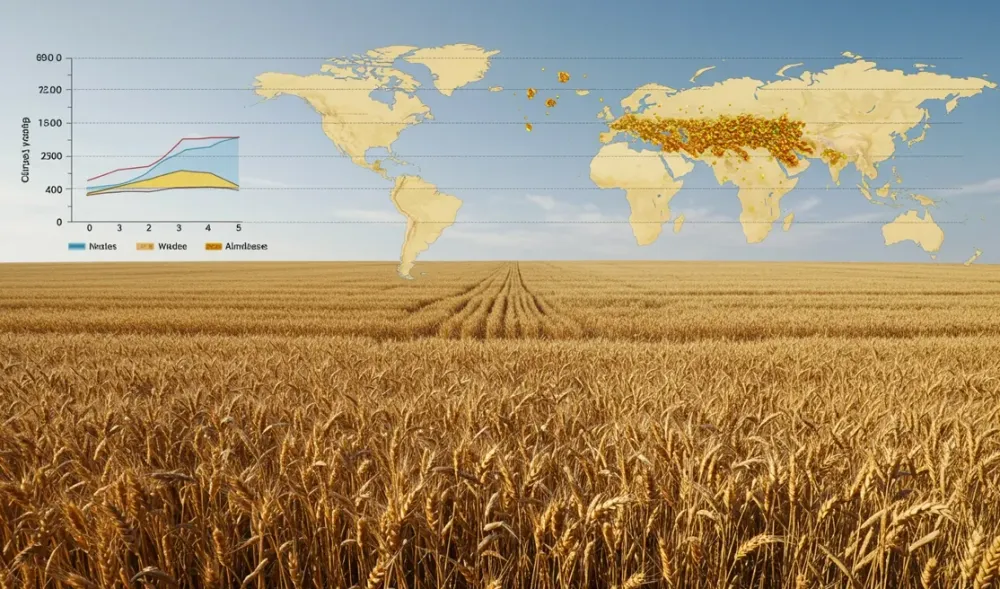How to Increase Wheat Crop Yield: Strategies for Productive Farming
Wheat is one of the most important cereal crops globally, providing essential nutrition and supporting food security. Farmers are always seeking ways to maximize productivity and ensure sustainable yields. Understanding the factors that influence growth, health, and efficiency is key to answering the question of how to increase wheat crop yield.
Understanding Wheat Crop Growth
The yield of a wheat crop depends on several stages of growth, including germination, tillering, heading, and grain filling. Each stage has specific nutrient, water, and environmental requirements. Proper management during these stages ensures that plants develop strong roots, robust stems, and healthy grains.Factors influencing wheat yield include:
- Soil fertility: Nutrient-rich soils support
strong plant development.
- Water
availability: Adequate irrigation prevents drought stress and supports
photosynthesis.
- Pest and
disease management: Protecting plants from infestations preserves yield potential.
- Variety
selection: High-yielding and disease-resistant wheat varieties adapt better to
local conditions.
Soil Preparation and
Fertility Management
Healthy soil forms the foundation for high wheat yields. To improve soil
fertility, farmers should:
- Conduct soil
tests to determine nutrient levels and pH.
- Apply organic
matter, such as compost or green manure, to enhance soil structure.
- Ensure balanced
fertilization with nitrogen, phosphorus, and potassium based on crop
requirements.
Using data-driven platforms like Saiwa can help
farmers monitor soil health and optimize nutrient management to increase wheat
crop yield efficiently.
Optimizing
Irrigation Practices
Water management is crucial for wheat production. Both water scarcity and
over-irrigation can negatively affect yield. Strategies to improve irrigation
include:
- Scheduling
watering based on crop stage and soil moisture levels.
- Using drip or
sprinkler systems to minimize water loss.
- Monitoring
weather patterns to prevent unnecessary irrigation.
By integrating AI tools, farmers can track soil moisture and climate data
more accurately. Platforms like Saiwa can provide real-time recommendations to
ensure optimal water use.
Pest and Disease
Control
Wheat is susceptible to a range of pests and diseases, including aphids,
armyworms, rust, and mildew. Effective control measures help prevent yield
losses:
- Monitor crops
regularly for early signs of infestations.
- Use integrated
pest management (IPM) combining biological, chemical, and cultural control
methods.
- Rotate crops to
reduce pest pressure and disease buildup in the soil.
Early detection and management minimize damage, allowing wheat plants to
reach their full yield potential.
Weed Management
Weeds compete with wheat for nutrients, water, and sunlight. Implementing
effective weed control strategies is critical for maximizing yield. Techniques
include:
- Mechanical
weeding and timely hand removal in small fields.
- Targeted
herbicide application to reduce competition without harming the crop.
- Crop rotation
and cover crops to suppress weed growth naturally.
Regular monitoring ensures weeds are addressed before they affect the
wheat crop significantly.
Use of High-Yielding
Varieties
Selecting appropriate wheat varieties suited to local conditions is
essential. Modern varieties often offer higher yield potential, disease
resistance, and adaptability to different climates. Farmers should consider:
- Grain quality
and market demand.
- Resistance to
local pests and diseases.
- Tolerance to
drought or variable soil conditions.
Combining high-quality seeds with optimized farming practices
significantly boosts wheat crop yield.
Precision
Agriculture Techniques
Advancements in technology have made precision agriculture a key factor
in increasing wheat production. Tools such as GPS-guided machinery, remote
sensing, and AI-based monitoring allow farmers to apply inputs more efficiently
and track crop health in real time.
Benefits of precision techniques include:
- Accurate
fertilizer and pesticide application.
- Identification
of nutrient deficiencies through imaging.
- Real-time
insights for early intervention.
Using digital platforms and AI monitoring tools like Saiwa can streamline
precision agriculture practices, helping farmers make data-driven decisions for
maximum productivity.
Crop Rotation and
Soil Health
Rotating wheat with legumes or other crops improves soil fertility and
reduces pest pressure. Legumes fix nitrogen in the soil, enhancing nutrient
availability for the next wheat crop. Crop rotation also breaks pest and
disease cycles, contributing to healthier plants and higher yields.
Harvesting at the
Right Time
Timing the harvest correctly is essential to prevent yield losses and
maintain grain quality. Farmers should consider:
- Grain moisture
content to avoid spoilage.
- Weather
conditions to minimize exposure to rain or wind damage.
- Using efficient
harvesting machinery to reduce losses in the field.
Proper harvesting ensures that the maximum potential yield is collected
efficiently.
Post-Harvest
Management
Post-harvest practices also influence overall productivity. Proper
storage, drying, and handling prevent losses due to pests, mold, or spoilage.
Maintaining high grain quality ensures that the yield achieved translates into
profitable output.
Sustainable
Practices for Long-Term Yield
Sustainability is critical in modern agriculture. Long-term soil health,
resource efficiency, and environmental protection all contribute to stable
yields. Practices include:
- Using organic
amendments and natural fertilizers.
- Minimizing
chemical input through precision applications.
- Protecting
biodiversity and beneficial organisms.
By adopting these practices, farmers not only improve wheat crop yield
today but also ensure productivity in future seasons.
Conclusion
Knowing how to increase wheat crop yield requires a holistic
approach that integrates soil management, irrigation, pest control, variety
selection, and advanced technologies. By monitoring crops carefully, applying
data-driven strategies, and implementing sustainable practices, farmers can achieve
higher productivity while reducing environmental impact.
Digital platforms and AI solutions, such as Saiwa, provide valuable
insights for soil and crop management. Using these tools can optimize nutrient
use, detect issues early, and support efficient irrigation practices, making
wheat farming more productive and sustainable.
With proper planning, modern technology, and attention to crop health,
farmers can maximize wheat yield and contribute to food security and economic
growth.





Comments
Post a Comment